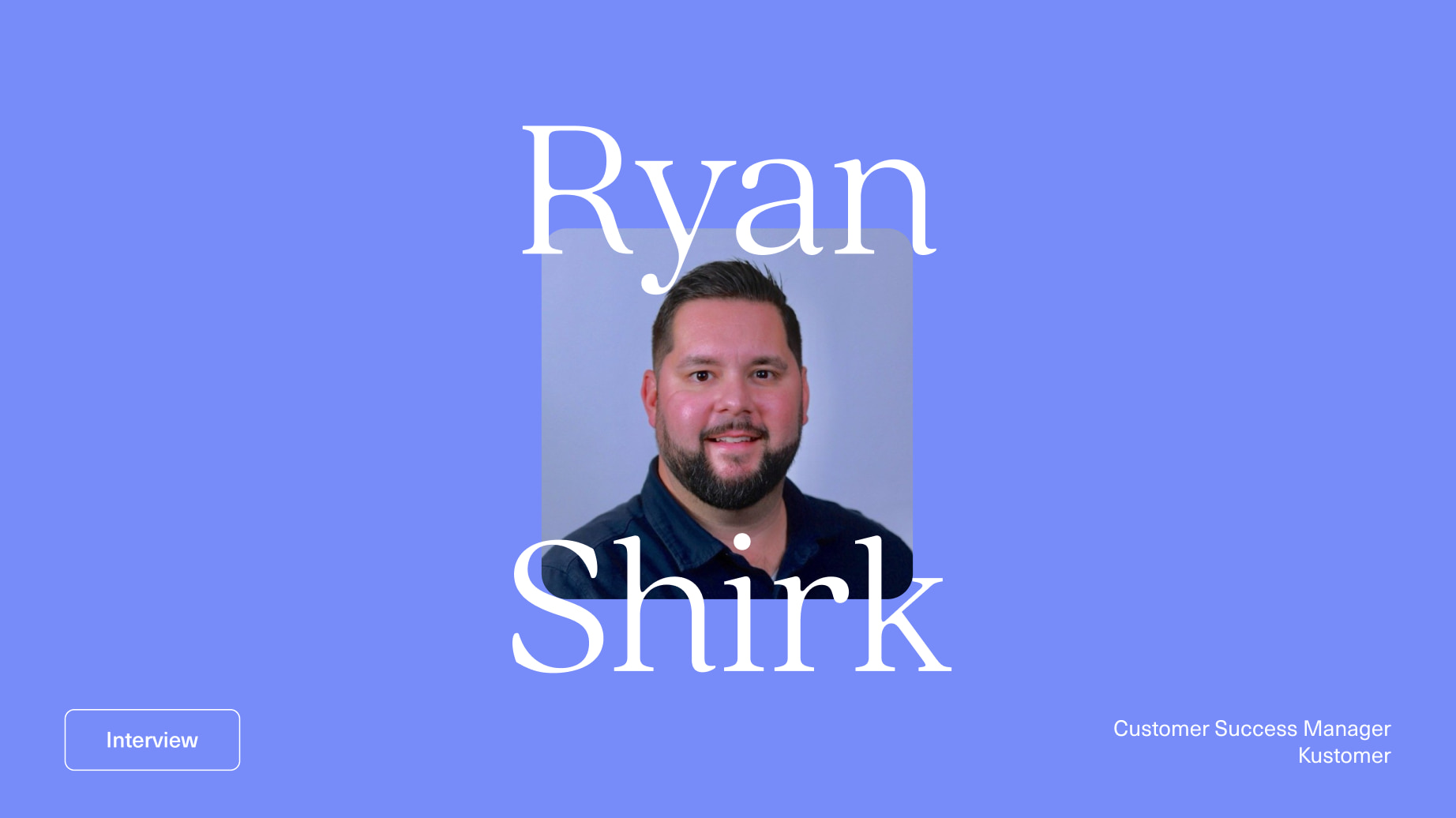Sam Chandler, our Director of Commercial Customer Success, recently sat down to talk about one of the most pressing topics in customer experience today: how to roll out AI successfully in the contact center.
Ryan Shirk, a Customer Success Manager on our team, has over a decade of experience in conversational AI. He’s worked closely with some of the world’s largest brands, helping them navigate digital transformation and implement AI solutions that drive real business impact.
They sat down to discuss Ryan’s perspective on how the landscape of AI has evolved from the models themselves to the strategic frameworks that determine whether those models succeed or fail. As he explains, today’s secret sauce relies less on the AI model and more on the thoughtfulness of the rollout.
This interview covers Ryan’s proven crawl-walk-run framework for AI adoption, common pitfalls he’s seen organizations face, and the critical role of clean data and success metrics in building trust and driving adoption.
This interview has been lightly edited for clarity.
Sam Chandler: I would love to hear—tell us what you see as the keys to a successful rollout, specifically with AI. What have you seen work really well?
Ryan Shirk: So, number one is to have a strategic plan in place. Having this plan—I'll go through it in a minute—but having this plan in place where you're taking a crawl, walk, run approach to establishing your AI journey and really introducing it into your contact center is crucial.
Number two is clean data. Without a data strategy, there's really no AI strategy. Starting foundationally with a clean data source and data structure is really crucial to a successful AI rollout.
Sam Chandler: People forget about that data part. AI is not set and forget, and you are absolutely correct there. So thinking of it in those terms, where do you see most customer experience organizations falling short on rolling these things out? What are the common mistakes that you see made?
Ryan Shirk: I think at this point, everyone knows that they want AI and they want to turn AI on across their business. But where I've seen companies fail is trying to use an easy button approach where they come in, they turn it on across the board without any real strategy and without making sure that their data sources are completely clean.
Ultimately, that ends in failure because the AI is leveraging bad data—maybe old data or antiquated. As it's implemented, you're not getting the results that you're wanting to get out of the AI. That, and also making sure that success criteria is built for each phase, and you have a clean way of measuring the success and the impact on the business.
Sam Chandler: love that. The adoption element—people think about it and they're like, “Why isn't this working? Nobody's using it. It must not work very well.” You think about those elements of the planning process that most organizations don't think about—makes total sense.
Well, luckily, they have you to think about that for them because you have an amazing framework that you have developed through working with all of these companies. Walk us through this. Tell us about this framework, how it came to be, and the key components of it.
Ryan Shirk: I mentioned before, but this framework that I've built out is based on a crawl, walk, run approach to implementing AI in your contact center. It's a very prescriptive approach that—again, back to the success criteria—we're defining success criteria for each phase, and we make sure that we have a very clear path to measuring the success or failure of it.
The crawl aspect of it is what customers call AI Agents for Reps. This includes things like Copilot, SmartWrite tools, and conversation summaries. This is all internal-facing AI that is not being shown to the end consumer but only to the agents and internal staff.
It understands a customer's context based on previous inquiries they've had with the company. It understands stored data like recent orders, returns, card details, things like that. It also connects to internal FAQs to surface the right content to the right agent at the right time. It generates summaries of context for each conversation and posts it to the customer's timeline.
The next step would be considered walk. This is everything from the crawl step, into the walk step. You spend some extra time looking at the results. Make sure the data is fine-tuned and cleaned up, including your FAQs. Make sure that the AI agents are producing valuable information to the reps. This is also a step where you're introducing tasks into the mix. While there's still a safeguard of a human sitting between the task completion and the end consumer, we allow the AI to interact with backend systems and offer up a task. For example, order or account management systems, or let's say a return. It will offer that up as a solution to the agent, who then decides whether to execute the task or continue interacting with the consumer.
From there, we move to the run stage. This includes everything from the crawl and walk phases, and then introduces full automation. The AI performs fully automated tasks and executes them from start to finish. It has two-way integration into backend systems via APIs. It can pull, query, and post data to endpoints in third-party systems. Also, the tasks from the walk phase—AI now makes the decision: Do I execute this task? Do I return this order? Process a cancellation or a password reset? That’s the framework that I’ve built and used with customers, and have seen great results.
Sam Chandler: This is amazing. This makes me think of two things. First, the number one frustration that customers always talk about with support is having to repeat themselves. Your framework includes all of this metadata that customers expect us to have anyway and to utilize. So I love that. I think about trust. The main thing I hear when I talk to executives in the CX space and CTOs is, “We don’t trust it to give the answer yet.” They’re afraid of giving AI that much leeway.
Your framework—crawl to walk to run—allows people to test out the waters. It builds trust with their team using an AI component like AI agents for reps that speaks to the agent, helps them do their job better, and builds that trust. This is really an awesome framework.
Ryan Shirk: Absolutely. Totally agree.
Sam Chandler: So, we both know that there are organizations that are much more adept at bringing a plan to life than others. Talk to me about what it takes to get an AI rollout from the crawl stage into the walk stage. Is there a certain amount of time or team members? Different tech stacks? Can anybody do this or does it take a certain amount of resources to get this right?
Ryan Shirk: Good question. So again, back to the data piece. If you're fully addressing your data and making sure that it's very clean, up to date, and usable in phase one, phase two could be anywhere from four to eight weeks or so, just depending. It really depends on the data and how clean it is. That determines how fast we can move from phase one to phase two. That’s really the checkpoint: the data and the validity of the AI responses.
To your point, Sam, you can rely on your agents to provide feedback to the teams. You also see adoption. Agents aren't going to use summaries or contextual data if it’s not accurate and clean. So again, it really comes back to the data to determine how quickly you can move into phase two, where you're producing tasks that agents can make decisions on.
Sam Chandler: Clean data. Who knew? It always comes back to clean data.
Ryan Shirk: Absolutely.
Sam Chandler: This next question might seem obvious to you, but some of us need it spelled out. Why is it important to have a strategic plan for AI rollout in the first place? Why should any of us care about this?
Ryan Shirk: Looking back at the last couple of years with the evolution of AI, it's a new technology and a new way of thinking and working. Without a strategic plan, it can go in many directions. It's very easy to get off track if you're not following a prescriptive plan.
That’s the key to having a strategic success plan—making sure things stay on the rails. Again, back to success criteria: each phase of your journey should be very prescriptive in how you're measuring success. If you're falling short, come up with an action plan to address those items before you move on to the next phase.
Sam Chandler: Plan of success. Plan of attack. I love it. So putting all this together, wrapping it up—if people don’t remember anything else, what’s the one key takeaway, Ryan?
Ryan Shirk: I think the number one thing is to have a prescriptive approach to how you're deploying AI across your technology stack and in your contact center. The plan is number one. A big part of that plan is clean data. You have to make sure you have clean data in order to follow the plan. And then last but not least, establish a way to measure the impact on the business.
Sam Chandler: Love it.
Closing thoughts
AI is the next big innovation in customer success and contact center technology. It's time to start making your plan for how your team will use it.
Looking for a new CRM and customer support platform that will help you take advantage of AI? Download our guide today to help you evaluate the best customer service CRM tools and use AI to get an edge over the competition.
Ready to take the next step and explore how AI can supercharge your CX strategy? Schedule your demo of Kustomer today or take a self-guided product tour.




